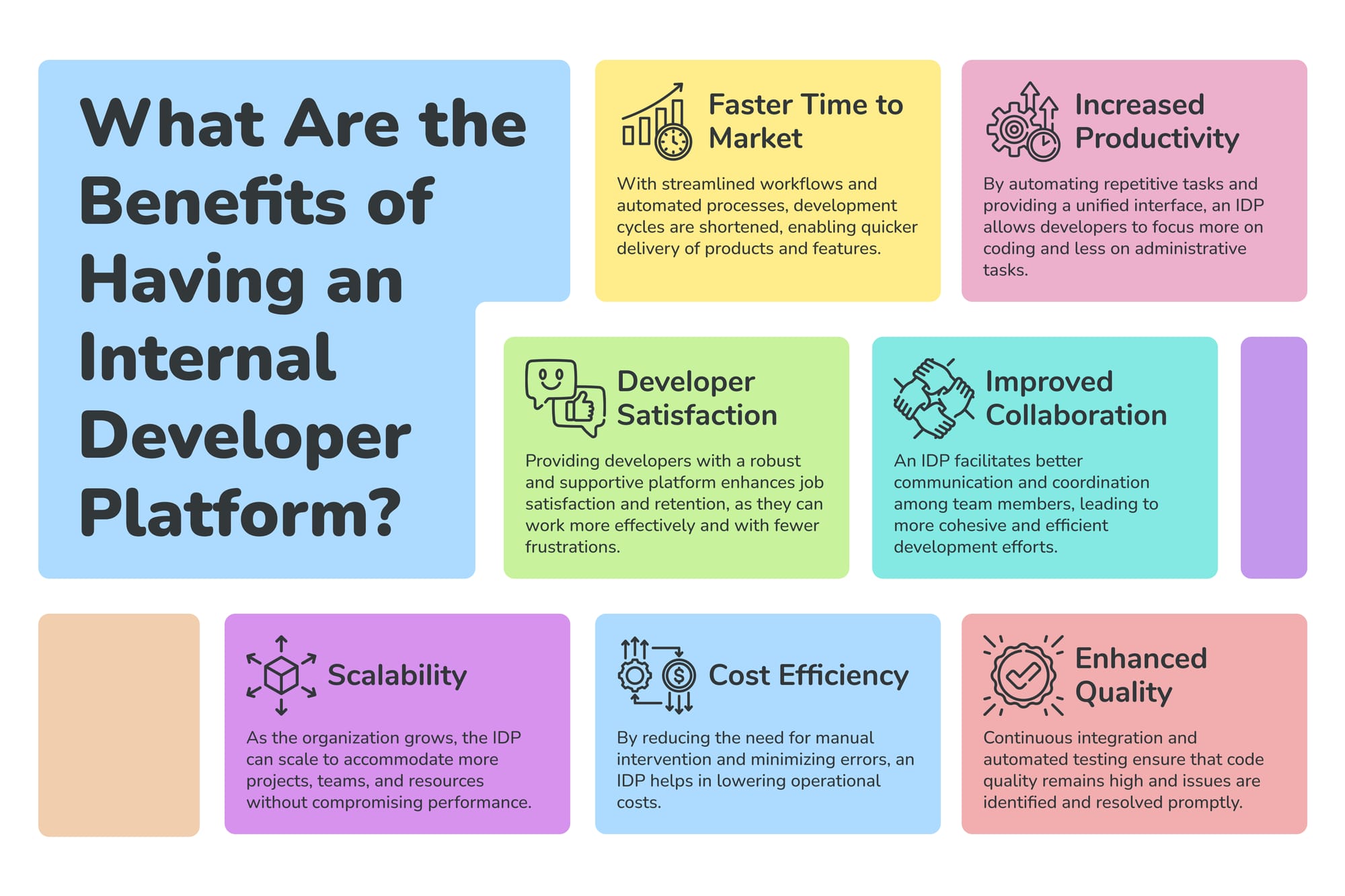An Internal Developer Platform (IDP) is an essential tool that helps development teams streamline their workflows, enhance productivity, and foster innovation. In recent months, there has even been a significant surge in the adoption of IDPs, driven by the increasing pressure to deliver software faster and more reliably. Internal developer platforms are worth considering for any organization looking to enhance their software development capabilities. But what exactly is an IDP, and how does it differ from traditional DevOps practices?
What Are Internal Developer Platforms?
Internal Developer Platforms, often abbreviated as IDPs, are comprehensive systems designed to support the entire lifecycle of software development within an organization. These platforms provide developers with the essential tools, environments, and services to build, test, deploy, and manage applications efficiently.
An IDP platform aims to reduce the complexities of the development process by offering a unified interface and automating repetitive tasks, allowing developers to focus on writing code and solving problems. Effective infrastructure management is a critical component of IDPs, allowing development teams to focus on innovation and code quality.
IDPs typically include features such as:
- Integrated Development Environments (IDEs): Providing a cohesive workspace for coding, debugging, and testing.
- Continuous Integration/Continuous Deployment (CI/CD) Pipelines: Automating the build, test, and deployment processes.
- Infrastructure as Code (IaC): Managing infrastructure through code, making it easy to provision and configure resources.
- Monitoring and Logging: Offering insights into application performance and identifying issues in real-time.

What Is the Difference Between Internal Developer Platforms and Internal Developer Portals?
Internal Developer Portals are user interfaces or platforms that provide access to various development tools, resources, and documentation within an organization. These portals serve as a centralized hub where developers can find everything they need to perform their tasks. Key features of an Internal Developer Portal include:
- Unified Access: A single point of entry for accessing all development tools and resources.
- Documentation Repositories: Centralized location for API documentation, guidelines, and best practices.
- Resource Management: Easy access to shared resources like libraries, frameworks, and development environments.
- Collaboration Tools: Features that facilitate communication and collaboration among team members.
The primary goal of an Internal Developer Portal is to improve accessibility and ease of use, ensuring that developers can quickly find and utilize the resources they need without having to navigate multiple systems or interfaces.
Key Differences
- Scope and Functionality:
- Internal Developer Platform (IDP): Focuses on providing the necessary tools and infrastructure to support the entire software development process, including coding, testing, deployment, and monitoring.
- Internal Developer Portal: Serves as a centralized access point for all development-related resources, tools, and documentation, improving ease of use and accessibility.
- User Interaction:
- Internal Developer Platform (IDP): Developers interact with the platform to perform specific tasks like coding, testing, and deploying applications.
- Internal Developer Portal: Developers use the portal to access resources, find documentation, and collaborate with team members.
- Primary Goal:
- Internal Developer Platform (IDP): Aims to streamline and automate the development process, enhancing productivity and efficiency.
- Internal Developer Portal: Aims to provide a user-friendly interface for accessing development tools and resources, improving the developer experience.
- Implementation:
- Internal Developer Platform (IDP): Typically involves integrating various tools and services into a cohesive system that supports development activities.
- Internal Developer Portal: Focuses on aggregating and presenting existing tools and resources in a centralized, accessible manner.
What Is the Difference Between Platform Engineering and DevOps?
While both Internal Developer Platforms and DevOps aim to improve the efficiency and reliability of software development, they approach the challenge from different angles.
DevOps is a cultural and operational framework that emphasizes collaboration between development and operations teams. It focuses on practices, tools, and philosophies that enable continuous delivery, integration, and improvement.
DevOps aims to break down silos, foster a collaborative environment, and streamline the software development lifecycle through automation, monitoring, and shared responsibilities.
On the other hand, an IDP platform is a tangible product or system implemented within an organization to support and enhance the development process. It provides developers with the tools, environments, and resources needed to build and deploy software efficiently.
A dedicated platform team is often responsible for curating and optimizing the various technologies and tools within an IDP, ensuring seamless developer workflows.
While DevOps focuses on culture and practices, an IDP developer platform offers the concrete infrastructure and capabilities that enable these practices to be executed effectively.
Conclusion
The Internal Developer Platform (IDP) is a crucial component in modern software development, providing developers with the tools and environments needed to build and deploy applications efficiently. While DevOps focuses on cultural and operational improvements, an IDP platform offers the tangible infrastructure to support these practices. By understanding and implementing an IDP, organizations can streamline their development workflows, enhance productivity, and drive innovation in their software projects.





